|
|

|
Travel by ship formed an abiding memory for so many who lived and worked around the Empire. It could take weeks or even months to get to your destination and getting to the ports and to your final destination might take even more interesting forms of transportation. Given the distances, returns to Britain to see family and friends were only likely every couple of years or so at best. In the post-war period, air transportation was making inroads but the small and uncomfortable planes were more likely to be reserved for military purposes or diplomatic messages and tended to stop off at multiple airfields along a long and complicated route. It really was not until the advent of jetliners from the 1960s onwards that plane travel become comfortable enough and economic enough to displace ship travel. Until then the post-war period saw something of an Indian summer for liner travel. Many ships had been released from war duties and shipyards switched from making military ships to commercial and passenger vessels.
The ships could be of variable quality, but the sedate form of travel allowed people to mix with unusual travelling companions who were off to equally exotic or remote locations. Passengers were at the mercy of the elements and also somewhat to the class of ticket they could afford or had been provided with. Ships would break up the monotony with on board entertainment, sports, games and various rituals such as crossing the equator. The memories of people like Stephanie Hewat-Jaboor (nee Brend) whose own family were posted to Eritrea and Tanzania are perhaps typical of those who experienced ship travel in the last days of Britain's Empire in Africa: "The first ship my family travelled on was the EMPIRE KEN, which I believe was a converted German Ship, which had been used by the SS officers as a holiday cruise ship. My family were travelling to Eritrea at that time. The ship was full of Italian prisoners of war who were dropped off in Italy, none of them seemed keen to return there. The next ship I recall was the Llangibby Castle which was on it's last voyage before being scrapped. I understand why it was scrapped as my clearest memory of that ship was the dreadful food and loads of cockroaches!! We also travelled on one of the Italian boats from the LlOYD TRESTINO shipping line. It was nicely finished but travelled like a cork on water, with no stabilizers. We also travelled to and from East Africa on other UNION CASTLE ships. One in particular that I remember was the PRETORIA CASTLE. We travelled closely with a French speaking Belgian family who were travelling to the Congo. We were sad to learn that they were killed in a massacre shortly after reaching their home in the Congo. Air travel was ghastly. It was mostly Argonaut planes that stopped half a dozen times getting from a very basic Heathrow airport to Nairobi." Margaret Reardon's memoirs were written as An Unexpected Journey. She had many more photographs of the various sailings she and her family took going to and from Africa in the 1950s and 1960s. These have been kindly made available to us here: |
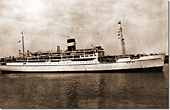 |
 |
|
| R.M.S. Karanja | M.S. Randfontein | |
 |
||
| M.S. Jagersfontein | ||
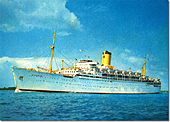 |
||
| SS Chusan |
 |
 |
|
| M.S. Boschfontein | Crossing the Line Ceremony | |
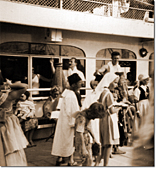 |
||
| Fancy Dress Party | ||
 |
||
| Mombasa 1956 |
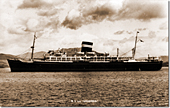 |
 |
|
| S.S. Uganda, c1956 | First Class Dining Saloon | |
 |
||
| First Class Drawing Room | ||
 |
 |
|
| First Class Smoking Room | First Class Cabin | |
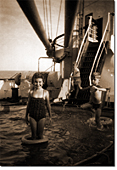 |
||
| Swimming Pool | ||
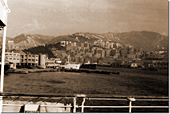 |
||
| Genoa Port |
Articles | Library | Unexpected Journey
Armed Forces | Art and Culture | Articles | Biographies | Colonies | Discussion | Glossary | Home | Library | Links | Map Room | Sources and Media | Science and Technology | Search | Student Zone | Timelines | TV & Film | Wargames